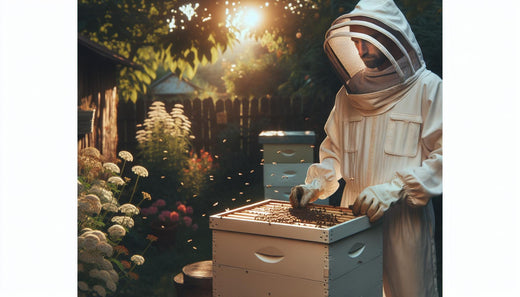For anyone venturing into the world of beekeeping, selecting the right bee suit is paramount. A quality suit not only shields against stings but also ensures a safer and more enjoyable beekeeping experience. With a range of styles, materials, and features available, finding the best bee suit may seem overwhelming—whether you’re a novice or a seasoned beekeeper.
Investing in the right bee suit means prioritizing protection, comfort, and functionality. From full-body suits to simple jackets, your choice of gear can significantly enhance your time spent tending to hives. This guide explores the top considerations for selecting a bee suit, highlights leading brands, and provides essential maintenance tips to ensure your suit lasts for years to come.
Overview of Bee Suits
Bee suits are essential pieces of equipment for beekeepers. These garments protect against bee stings while providing comfort and mobility during hive inspections. Available in various styles—full-body suits, jackets, and ventilated options—they cater to diverse preferences and climatic conditions.
Common Materials:
-
Cotton: Soft, breathable, and durable, cotton suits are a classic choice.
-
Polyester: Lightweight and quick-drying, polyester suits are ideal for humid conditions.
-
Blends: Many modern suits feature a mix of cotton and polyester for the best of both worlds.
-
Ventilated Mesh: Suits with mesh panels offer superior airflow, making them perfect for hot climates.
Key features to look for include:
-
Reinforced Stitching: Enhances durability and withstands frequent use.
-
Elastic Cuffs and Closures: Prevents bees from entering the suit through openings.
-
Collapsible Veils: Combines visibility with protection, allowing for convenient storage when not in use.
When selecting a bee suit, prioritize fit and ventilation. A proper fit reduces exposure risks, while ventilation ensures comfort, especially in warmer weather. Leading brands like Mann Lake, Bee Smart Designs, and VIVO offer high-quality options that balance protection, durability, and ease of use.
Features to Consider When Choosing a Bee Suit
The best bee suit is one that provides the right balance of protection, comfort, and functionality. Here are the key features to evaluate:
1. Material Quality
Material quality determines the suit’s durability and effectiveness in protecting against stings. Common options include:
-
Lightweight Fabrics: Promote breathability and minimize heat buildup.
-
Tightly Woven Materials: Offer superior sting resistance.
-
Ventilated Mesh Panels: Enhance air circulation while maintaining protection.
High-quality materials not only resist wear and tear but also ensure long-term reliability.
2. Protection Level
A good bee suit must offer robust protection against stings. Look for:
-
Double-Layer Construction: Adds an extra barrier, particularly in high-risk areas like the shoulders and chest.
-
Elastic Cuffs and Ankles: Securely seal off potential entry points for bees.
-
Sturdy Veils: Ensure visibility while preventing bees from reaching the face and neck.
Some suits also include additional padding for high-risk areas, providing extra confidence during hive inspections.
3. Comfort and Fit
A well-fitting suit is essential for ease of movement. Features that enhance comfort include:
-
Adjustable Straps: Allow for a customized fit.
-
Lightweight Design: Reduces fatigue during prolonged use.
-
Ventilation: Keeps beekeepers cool, especially in hot weather.
Proper sizing is crucial—a suit that’s too tight may restrict movement, while one that’s too loose could expose skin to stings.
4. Additional Features
Some suits come with convenient extras, such as:
-
Tool Pockets: Handy for carrying hive tools and other essentials.
-
Detachable Veils: Offer versatility for different beekeeping activities.
-
Zippered Closures: Make it easy to put on and remove the suit.
Top Bee Suit Recommendations
Here are three top-rated bee suits, each offering unique features to meet various needs:
1. Mann Lake Full-Body Bee Suit
-
Material: Cotton-polyester blend
-
Key Features: Reinforced stitching, collapsible veil, elastic cuffs
-
Why It Stands Out: This suit balances durability and breathability, making it ideal for both beginners and experienced beekeepers. Adjustable straps ensure a snug fit, enhancing safety during hive inspections.
2. Bee Smart Designs Ventilated Jacket
-
Material: Lightweight mesh fabric
-
Key Features: Removable veil, ventilated panels, spacious pockets
-
Why It Stands Out: Perfect for beekeepers in warm climates, this jacket prioritizes airflow and comfort. Its tailored fit promotes mobility while maintaining sting protection.
3. VIVO Professional Bee Suit
-
Material: Heavy-duty polyester
-
Key Features: Mesh veil, zippered front, elastic closures
-
Why It Stands Out: Durable and practical, this unisex suit caters to a wide range of body types. Its sturdy construction ensures long-lasting performance, even during intensive beekeeping tasks.
Maintenance and Care Tips
Proper care extends the life of a bee suit and ensures it remains effective. Follow these tips to keep your suit in top condition:
1. Wash Regularly
-
Remove bee propolis, honey, and dirt by washing the suit after each use.
-
Use cold water and mild detergent to avoid damaging the fabric.
-
Avoid bleach and fabric softeners, as these can degrade materials.
2. Air Dry
-
Air dry your suit in a shaded, well-ventilated area.
-
Avoid direct sunlight, which can weaken fabric fibers and cause fading.
3. Store Properly
-
Store the suit in a cool, dry place to prevent mildew.
-
Hang or fold it neatly to avoid creases that may compromise its protective properties.
4. Inspect for Damage
-
Regularly check for tears, loose seams, or damaged zippers.
-
Repair minor issues promptly using a sewing kit or specialized patch kit.
5. Maintain the Veil
-
Inspect the veil for holes or tears, and replace it if visibility is impaired.
-
Clean the veil gently with a damp cloth to maintain clarity.
By following these care tips, beekeepers can ensure their suits remain reliable and effective for years to come.
Conclusion
Choosing the best bee suit is a vital step in ensuring safety, comfort, and efficiency in beekeeping. By considering factors like material quality, protection level, and fit, beekeepers can find a suit that meets their specific needs. Regular maintenance further extends the life of the suit, ensuring it remains a dependable part of any beekeeper’s toolkit.
With the right bee suit, beekeepers can confidently engage with their hives, fostering a thriving bee population while minimizing the risk of stings. Whether you’re starting out or looking to upgrade your gear, investing in a quality bee suit is a decision that will enhance your beekeeping journey for years to come.
Frequently Asked Questions (FAQs)
1. What is the purpose of a bee suit?
A bee suit protects beekeepers from stings while providing comfort and mobility. It is an essential safety tool that allows for safe hive inspections and other beekeeping activities.
2. What materials are commonly used for bee suits?
Bee suits are typically made from cotton, polyester, or blends of the two. Ventilated suits often feature mesh panels for enhanced airflow, making them suitable for hot climates.
3. How should a bee suit fit?
A bee suit should fit comfortably—not too tight to restrict movement or too loose to expose skin. Look for adjustable features, such as straps or elastic closures, to achieve a secure fit.
4. What features should I prioritize when choosing a bee suit?
Key features include material quality, protection level, comfort, and ventilation. Additional elements like reinforced stitching, tool pockets, and detachable veils can enhance usability.
5. How can I maintain my bee suit for longevity?
To maintain your bee suit:
-
Wash it with mild detergent after each use.
-
Air dry in a shaded area.
-
Store in a cool, dry place.
-
Inspect regularly for damage and repair as needed.
-
Keep it away from pesticides or harsh chemicals.



